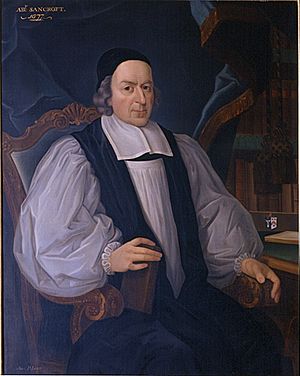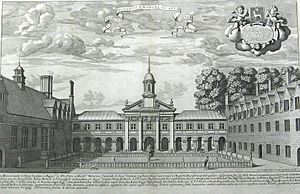William Sancroft facts for kids
Quick facts for kids The Most Reverend and Right Honourable William Sancroft |
|
|---|---|
| Archbishop of Canterbury | |

Portrait by Bernard Lens II
|
|
| Church | Church of England |
| Diocese | Canterbury |
| In Office | 1677–1690 |
| Predecessor | Gilbert Sheldon |
| Successor | John Tillotson |
| Orders | |
| Consecration | 27 January 1677 by Henry Compton |
| Personal details | |
| Born | 30 January 1617 Ufford Hall, Fressingfield, Suffolk, England |
| Died | 24 November 1693 (aged 76) Ufford Hall, Fressingfield, Suffolk, England |
| Buried | Church of St. Peter and St. Paul, Fressingfield |
| Nationality | English |
| Denomination | Anglican |
| Education | King Edward VI School |
| Alma mater | Emmanuel College, Cambridge |

William Sancroft (born January 30, 1617 – died November 24, 1693) was a very important leader in the Church of England. He was the 79th Archbishop of Canterbury, which is the highest position in the Church of England.
William Sancroft is famous for being one of the Seven Bishops. In 1688, these bishops were put in prison. They had spoken out against King James II because they disagreed with his new rules about religion. Sancroft refused to promise loyalty to the new rulers, William and Mary, who took over from King James. Because of this, he lost his job in 1690. He then helped other church leaders who also refused to swear loyalty, which led to a split in the church called the nonjuring schism.
Contents
Early Life and Education

William Sancroft was born at Ufford Hall in a village called Fressingfield, in Suffolk, England. His father was Francis Sandcroft and his mother was Margaret Butcher.
He went to the Bury St Edmunds free grammar school. After that, in 1633, he went to Emmanuel College, Cambridge, a famous university. His uncle, William Sancroft the Elder, was in charge of the college at that time. William Sancroft studied hard and earned his first degree in 1638. He became a fellow (a kind of teacher or researcher) at the college in 1642.
However, he was removed from his position in 1649. This happened because he refused to agree to a new rule called the "Engagement." This rule asked people to promise loyalty to the government that was in power after the English Civil War.
Return to England and Church Work
Sancroft left England and stayed abroad for some time. He came back after the Restoration, which was when the king was put back on the throne in 1660. After his return, he became a preacher for the university. In 1662, he was chosen to be the Master of Emmanuel College, his old university. He held this job until 1665.
While he was Master, he started raising money to build a new chapel for the college. He gave a lot of his own money to help with the costs. The chapel was finished in 1667 and was designed by the famous architect Christopher Wren.
In 1663, Sancroft was chosen to be the Dean of York. A dean is a senior leader in a cathedral. The next year, in 1664, he became the Dean of St Paul's in London. He played a very important role in rebuilding St Paul's Cathedral after the Great Fire of London in 1666. He gave £1400 of his own money to the rebuilding effort. He also rebuilt the deanery, which was the dean's house, and made sure it had more income.
Becoming Archbishop of Canterbury
In 1677, William Sancroft was unexpectedly chosen to be the Archbishop of Canterbury. The king, Charles II, specifically wanted him for the job. Sancroft was not eager to accept, but the king convinced him.
He was with King Charles II when the king was dying. Sancroft gave him strong advice and spoke very openly. In 1685, he crowned King James II.
A few years later, in 1688, King James II issued a "Declaration of Indulgence." This declaration gave more freedom to people who were not part of the Church of England. Sancroft and six other bishops disagreed with this. They wrote a petition (a formal request) against the king's declaration. For this, Sancroft, who was 71 years old, and the other six bishops were sent to the Tower of London. However, they were later found not guilty and set free. This event made them known as the Seven Bishops.
The Nonjuring Schism
When King James II left England, William Sancroft agreed with other leaders that there should be a free parliament. He also supported giving more freedom to other Protestant groups. However, when William and Mary became the new king and queen, Sancroft refused to swear an oath of loyalty to them.
Because he would not swear this oath, he was removed from his position as Archbishop in 1690. John Tillotson took over his duties in August 1690 and officially became the new Archbishop in April 1691. Sancroft was part of a group of clergy who refused to swear allegiance to William and Mary. This group was called the "Nonjurors," and their actions led to a split in the church known as the Nonjuring schism.
Sancroft also supported other scholars and writers. He helped Henry Wharton, a church historian, and Mary Astell, a writer.
From August 1691 until his death two years later, William Sancroft lived a quiet life in his home village of Fressingfield. He died at Ufford Hall, his family home. He was buried in the churchyard of Fressingfield, where there is a special message in Latin to remember him.
See also
- Harleston Sancroft Academy
Sources
| Academic offices | ||
|---|---|---|
| Preceded by William Dillingham |
Master of Emmanuel College, Cambridge 1662–1665 |
Succeeded by John Breton |
| Church of England titles | ||
| Preceded by Richard Marsh |
Dean of York Jan.–Nov. 1664 |
Succeeded by Robert Hitch |
| Preceded by John Barwick |
Dean of St Paul's 1664–1678 |
Succeeded by Edward Stillingfleet |
| Preceded by Gilbert Sheldon |
Archbishop of Canterbury 1678–1691 |
Succeeded by John Tillotson |

